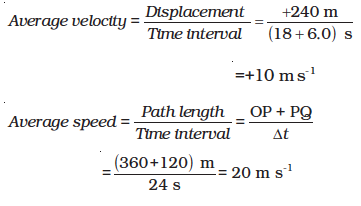When an object is in motion, its position changes with time. But how fast is the position changing with time and in what direction? To describe this, we define the quantity average velocity. Average velocity is defined as the change in position or displacement (∆x) divided by the time intervals (∆t), in which the displacement occurs :

where x2 and x1 are the positions of the object at time t2and t1, respectively. Here the bar over the symbol for velocity is a standard notation used to indicate an average quantity. The SI unit for velocity is m/s or m s–1, although km h–1 is used in many everyday applications.
Like displacement, average velocity is also a vector quantity. But as explained earlier, for motion in a straight line, the directional aspect of the vector can be taken care of by + and – signs and we do not have to use the vector notation for velocity in this chapter.

Fig. 3.4 The average velocity is the slope of line P1P2.
Consider the motion of the car in Fig. 3.3. The portion of the x-t graph between t = 0 s and t = 8 s is blown up and shown in Fig. 3.4. As seen from the plot, the average velocity of the car between time t = 5 s and t = 7 s is :

Geometrically, this is the slope of the straight line P1P2 connecting the initial position P1 to the final position P2 as shown in Fig. 3.4.
The average velocity can be positive or negative depending upon the sign of the displacement. It is zero if the displacement is zero. Fig. 3.5 shows the x-t graphs for an object, moving with positive velocity (Fig. 3.5a), moving with negative velocity (Fig. 3.5b) and at rest (Fig. 3.5c).

Fig. 3.5 Position-time graph for an object (a) moving with positive velocity, (b) moving with negative velocity, and (c) at rest.
Average velocity as defined above involves only the displacement of the object. We have seen earlier that the magnitude of displacement may be different from the actual path length. To describe the rate of motion over the actual path, we introduce another quantity called average speed.
Average speed is defined as the total path length travelled divided by the total time interval during which the motion has taken place :

Average speed has obviously the same unit (m s–1) as that of velocity. But it does not tell us in what direction an object is moving. Thus, it is always positive (in contrast to the average velocity which can be positive or negative). If the motion of an object is along a straight line and in the same direction, the magnitude of displacement is equal to the total path length. In that case, the magnitude of average velocity is equal to the average speed. This is not always the case, as you will see in the following example.
Example 3.1 A car is moving along a straight line, say OP in Fig. 3.1. It moves from O to P in 18 s and returns from P to Q in 6.0 s. What are the average velocity and average speed of the car in going (a) from O to P ? and (b) from O to P and back to Q ?
Answer (a)




Thus, in this case the average speed is equal to the magnitude of the average velocity.
(b) In this case,

Thus, in this case the average speed is not equal to the magnitude of the average velocity. This happens because the motion here involves change in direction so that the path length is greater than the magnitude of displacement. This shows that speed is, in general, greater than the magnitude of the velocity.
If the car in Example 3.1 moves from O to P and comes back to O in the same time interval, average speed is 20 m/s but the average velocity is zero !